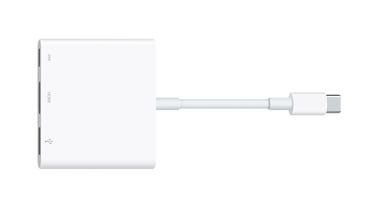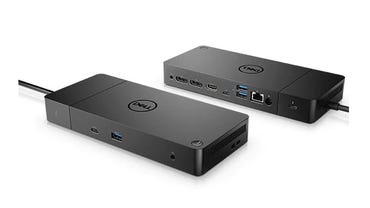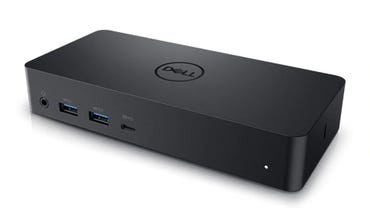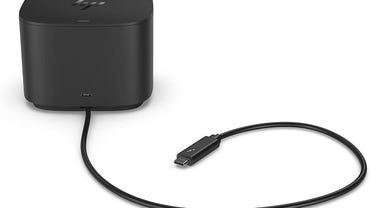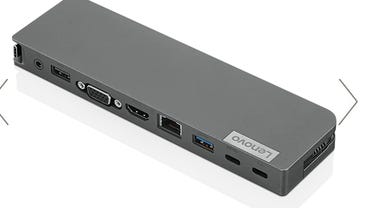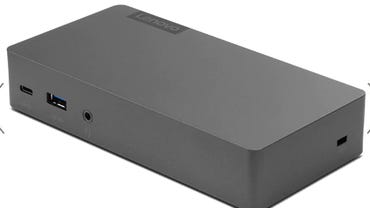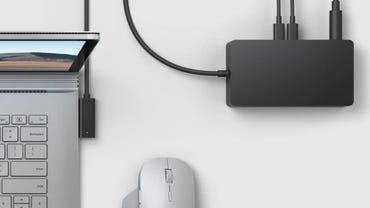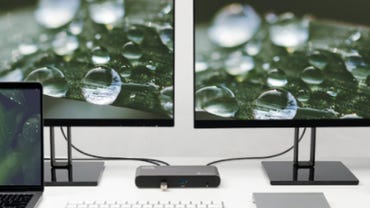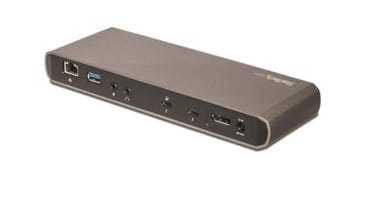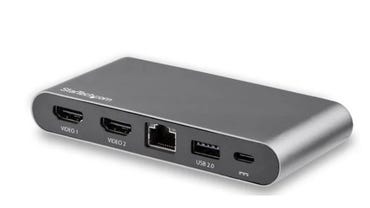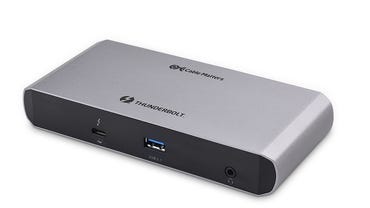Best laptop docking station (2022)
When the world turned upside down in early 2020, many of us went home for what we thought would be a brief break from office life. Instead, it's turned into a long-term commitment to remotely working. If you have kids, they're also doing remote schoolwork, going to classes on a computer screen.
Under the circumstances, maybe it's time to upgrade your work-from-home (WFH) setup with a docking station that transforms your laptop into a more comfortable working environment. With one (or maybe two) quick connections, you can add a full-sized external display, a full-sized keyboard and an external mouse, a wired Ethernet connection, and access to external devices like backup drives, scanners, and printers.
You can accomplish most of this for a relative pittance, or you can max out your platinum card with high-end solutions that support multiple displays and super-fast Thunderbolt 3 peripherals.
The basic concept behind a docking station is simple: It's a relatively small device that stays on your desk, connected to your monitor, keyboard, and mouse, plus whatever other devices you want to have readily at hand. When you're at your desk, you connect the dock to your laptop (typically via a single cable) and have instant access to the aforementioned external peripherals.
In this guide, we list some popular, well-reviewed dock options. But they're not all equal. Before you choose one for your work-from-home office, here's what you should look for.
- Connection type. This is probably the most important item on your sorting list. Most newish laptops support USB Type-C connections, which offer robust expansion options; before you choose one of these docks, though, you'll need to know if your laptop supports Thunderbolt 3 connections. If you have a Microsoft Surface device, your choices are more limited, thanks to the blade-type connector that those devices use for external connections. If you have an older PC or Mac that doesn't support one of those standards, you'll have to settle for some more basic dock options.
- Power. For a true one-cable connection, your dock needs to supply power to the laptop. Some less expensive docks skip this feature completely, assuming you'll connect a power supply and use the dock exclusively for connecting to peripherals. If you have a high-powered laptop, make sure your powered dock delivers enough watts to keep up with your PC's demands.
- Video output(s). Look very closely at the specs for video connections. If you need to drive only a single full HD (1920 x 1080) display using an HDMI cable, just about any dock will do. Things get complicated quickly if you need support for a 4K or 5K display (you'll need DisplayPort for those resolutions) or if you want to run two or more external displays simultaneously.
- Ports. Does the dock you're considering have enough external ports to connect to the devices you have on your desktop? Pay special attention to USB ports, which can be Type A or Type C, with or without the ability to power devices like a smartphone.
- Wired Ethernet. One of the great advantages of a docking station, if your network router is nearby, is that you can free yourself from sometimes flaky Wi-Fi connections and plug in directly. The participants on your weekly Zoom call will notice.
- Audio input/output. You probably won't think of these connections until you need them. But having dedicated external speakers and a 3.5-inch jack to plug an external microphone into can dramatically transform your audio quality. If you do webinars or guest appearances on broadcast media or podcasts, the difference is noticeable and worth paying for.
With those considerations in mind, we've divided the docking options into three major categories. First up are docks designed to connect specifically to a single brand of PCs. Next, we list generic docking stations that offer adequate expansion capabilities for under $150 (external peripherals not included). In the final section, we highlight more expensive third-party products that offer undeniable performance advantages for those who need the best.
In making our selections, we focused on docking stations designed for use with Windows laptops or MacBooks (or both). If you're looking to expand your Chromebook to the desktop, we recommend checking compatibility carefully. Among third-party hardware makers, only Kensington offers a wide selection of docks with ChromeOS support.
Docks for a specific PC brand
If you bought a name-brand PC, there's a good chance that the maker of that device has at least one and probably several dock options for you to choose from. The biggest advantage, of course, is that you can expect the two devices to work together properly; and if they don't, you don't have to put up with the finger-pointing that can occur when you encounter a conflict between a PC and a third-party peripheral.
This section includes information about docks designed for use with Windows PCs from Dell, HP, Lenovo, and Microsoft. As for Apple, well, let's get that out of the way first.
Apple USB-C Digital AV Multiport Adapter
Best Apple laptop docking option
We'd love to tell you about an Apple-branded docking station for use with your MacBook, but there is, alas, no such thing. The closest thing Apple offers is an overpriced dongle, the USB-C Digital AV Multiport Adapter. Plug the MacBook power adapter into the USB-C port, connect a monitor to the HDMI port, plug something into the single USB Type-A port, and that's it. You're out of expansion opportunities.
That might work if you have an Apple Bluetooth keyboard and mouse and you don't care about a wired network connection. But if your needs are demanding, you'll need to explore third-party products.
Ports: USB Type-C (1); USB Type-A (1)
Display: HDMI (1), 3840 x 2160
Dell Thunderbolt Dock – WD19TB
Best Dell laptop docking station
You can find a dizzying selection of docking stations at Dell's website, with a half-dozen Dell-branded docks on the Products For Work page and a much larger selection (including third-party solutions) on the Products for Home page.
For modern Dell PCs that include Thunderbolt 3 support, the WD19TB dock ($280) is the only way to go. It delivers 130W of power over the docking connection and has enough video connections to drive three big displays. You'll find one USB-C port and one USB 3.1 (Type A) port on the front panel, with the remainder of the ports on the rear, for devices that permanently stay connected.
Ports: USB Type-A (4); USB Type-C (1); speaker output; combo audio; Gigabit Ethernet
Display: HDMI (1); DisplayPort (2); up to three simultaneous 4K displays or a single 5K display
Dell
Best Dell laptop docking station for older models
You can find a dizzying selection of docking stations at Dell's website, with a half-dozen Dell-branded docks on the Products For Work page and a much larger selection (including third-party solutions) on the Products for Home page.
We suggest the $200 D6000 Universal Dock for older PCs that aren't equipped with USB-C Thunderbolt 3 ports. This dock has an impressive assortment of ports, delivers up to 65W of power, and can handle up to three displays at once. The downside is that the USB 3.0 connection uses DisplayLink technology, which can cause driver issues in some configurations.
Ports: USB Type-A (4); USB Type-C (1); speaker output; combo audio; Gigabit Ethernet
Display: HDMI (1); DisplayPort (2); up to three simultaneous 4K displays or a single 5K display
HP Thunderbolt Dock
Minimalist design for multiple connections
This docking station from HP is designed to help you stay connected to everything you need to work while also reclaiming desk space. The incredibly compact design lets you use a single USB-C cable to connect your compatible laptop to dual 4K monitors, external storage or external GPUs, and more. It features both USB-C DisplayPort and USB-C Thunderbolt 3 connections as well as 2 DisplayPort and 2 USB 3.1 inputs; it even has a VGA connection for using your laptop with older displays. There's also a Thunderbolt Dock Audio module you can purchase and connect for hands-free and headset-free conference calling and better sound for presentations.
Lenovo
Lenovo USB-C Mini Dock
Among the major OEMs, Lenovo wins the price wars with these two dock options. The basic USB-C Mini Dock is small enough to hide behind your laptop while still delivering up to 45W of power and enabling a full array of external device connections. For devices with Thunderbolt 3 support, the more powerful Essential Dock ups the power output to 65W and supports two 4K monitors with a single USB-C connection.
Ports: USB Type-C (1); USB 3.1 Type-A (1); USB 2.0 Type-A (1); Gigabit Ethernet; combo audio
Display: HDMI 2.0 (1); VGA (1); supports a single display up to 4K resolution using HDMI or 1080P using VGA
Lenovo
Lenovo Thunderbolt 3 Essential Dock
For Lenovo devices with Thunderbolt 3 support, the more powerful Essential Dock ups the power output to 65W and supports two 4K monitors with a single USB-C connection.
Ports: USB 3.0 Type-A (2); USB Type-C with no video support (2); Gigabit Ethernet; combo audio
Display: HDMI 2.0 (1); DisplayPort 1.4 (1); supports dual 4K displays
Microsoft Surface
Surface Dock 2
Microsoft's Surface Pro line has always been distinguished by its distinctive blade-style connector, which delivers power, video, and peripheral connections through a decidedly proprietary format. You'll also probably need adapter to connect the USB Type-C connectors on the rear to your external monitors. The latest entry in the company's docking options requires a reasonably modern Surface Pro device (Surface Pro 3 and 4 and original Surface Book not supported). If you meet those specs, you get 199W of power, support for dual 4K displays, and a total of six USB ports. The list price for this dock is much higher, but it's been discounted from Day 1.
Ports: USB 3.2 Type-A (2); USB Type-C (4); audio out; Gigabit Ethernet
Display: USB Type-C; supports up to two 4K displays at 60Hz
Third-party options
The biggest advantage of a third-party docking solution is flexibility. If you replace your laptop with a new model from a different manufacturer, you should be able to plug it into your existing dock and get right to work. For this section, we highlight docks from four leading manufacturers.
Plugable Thunderbolt 3 and USB-C docking station
Best laptop docking station
Don't let this dock's small size fool you; it packs a lot of power into a small package and can deliver 60W over USB-C to your laptop. The best feature is that you can use it with any system that includes USB-C support (with the noteworthy exception of HP's EliteBook 850 G3, which is incompatible). It's most effective, though, when connected to a system that supports Thunderbolt 3, including Dell's XPS 13 and 15 models, MacBook Air and Pros from 2016 or later, and Lenovo's popular ThinkPad Carbon X1 (6th Gen or later). The company's website has a useful compatibility chart that can help you determine whether the dock will work with your laptop.
Ports: USB 3.2 Gen 2 Type-A (2); USB 3.0 Type-A (2); USB Type-C (2); Gigabit Ethernet; combo audio
Display: DisplayPort (2); supports two 4K monitors at 60Hz (Thunderbolt 3) or two 1080p displays (USB-C)
StarTech.com Thunderbolt 3 docking station
Best high-end laptop docking station
You pay top dollar for StarTech.com's top of the line dock, but you get exactly what you pay for. With the ability to deliver 85W over USB-C PD, this is the best choice for anyone with a power-hungry, high-end laptop like a MacBook Pro 15 or 16. Don't even think of using it with a PC that doesn't support Thunderbolt 3, however.
Ports: USB 3.0 Type-A (2); USB Type-C Thunderbolt 3 (2); Gigabit Ethernet; separate microphone and speaker jacks
Display: DisplayPort (1); supports up to two 5K displays over DisplayPort and Thunderbolt 3
StarTech.com
Dual Monitor USB C Docking Station for Windows Laptops
If you have a Windows laptop that includes USB-C with Power Delivery but doesn't support Thunderbolt 3, consider the less expensive Dual Monitor dock; attach your laptop's USB-C power supply and you can power both your laptop and the dock with peripherals.
Ports: USB 3.0 (2); Gigabit Ethernet
Display: HDMI (2); supports a single ultrawide display, two 1080p displays at 60Hz, or up to two 4K displays at 30Hz
Kensington
Thunderbolt 3 and USB-C Hybrid Docking Station – SD5500T/SD5550T
Kensington's site is packed with useful technical information. If you're stumped about what the various connector specifications mean, visit its main page for some useful tech help. The SD5500T dock works with just about any modern Windows PC or Mac, with or without Thunderbolt 3 support.
Ports: USB 3 Type-A (3); USB Type-C (2); Gigabit Ethernet; combo audio
Display: DisplayPort (2); supports two 4K displays at 60Hz with Thunderbolt 3; with USB-C Alt Mode, supports one 4K display or two 1080p monitors at 30Hz
Kensington
SD7000 Surface Pro Docking Station
Surface Pro owners should take a long look at Kensington's SD7000 dock, which includes a cool hinge that can position the display at eye level or lay it down for use with a Surface Pen.
Ports: USB 3.0 (Type-A (4); USB Type-C (1), does not support alt mode; combo audio; Gigabit Ethernet
Display: HDMI 2.0 (1); DisplayPort 1.2 (1); supports a single 4K monitor at 60 Hz or two 4K displays at 30 Hz
Cable Matters
Thunderbolt 3/USB-C Hybrid Docking Station
This hybrid dock is ideal if you have multiple laptops (Mac or Windows) that have a mix of USB-C and Thunderbolt 3 connections. USB-C PD delivers up to 60W, which is enough for most midsize laptops. Windows PCs might need Thunderbolt 3 updates and custom network drivers to work properly. Note that the manufacturer specifically advises that Chromebooks are not compatible with this dock.
Ports: USB 3.0 Type-A (2); USB Type-C (2); Gigabit Ethernet; combo audio
Display: DisplayPort (2); supports one 5K display or up to two 4K displays with Thunderbolt 3; in USB-C Alt Mode, supports one 4K display or two 1080p displays at 30Hz
What is the best laptop docking station?
The Plugable Thunderbolt 3 and USB-C docking station is the best laptop docking station. We compared important docking station specifications, including price, connection type, power, video outputs, ports, audio input/output, and wired ethernet to find the best option for you.
What does a docking station do for a laptop?
A docking station lets you easily connect a single, or multiple, external displays, external storage devices or GPUs, and other devices to your laptop. It essentially allows your laptop to behave the same way as a traditional desktop tower while letting you multitask across multiple screens or more easily access different storage devices.
Are laptop docks universal?
There are universal docking stations available, and they will not only work with multiple models of Windows-based laptops, but also MacBooks. However, there are also many models out there which are made to work with specific brands or models. Dell, HP, and Apple all make docking stations that will only work with their products, but if you get a third-party docking station, it should work with anything you have; though you should check the user manual and user reviews to make sure.
What's the difference between a USB hub and a docking station?
A USB hub is a device that used when your laptop or desktop has limited integrated ports, and gives you more ways to connect peripherals like mice and keyboards as well as thumb drives and external hard drives. A docking station can do that as well, but they also have ports for connecting monitors via DisplayPort or HDMI cables so you can have a second (or third, or fourth) screen for easier multitasking when you need to work on your laptop.

